To be able to fulfill such a dual role, scientists take advantage of the different gas emissions from volcanoes. About 50-90 % of the gas emitted by volcanoes is water vapor. The rest is highly variable from one volcano to another, but CO2 can be 1-40 %, SO2 1-25 %, H2S 1-10 %, and HCl 1-10 %, plus a lot of other minor gases. H2S gets quickly oxidized to SO2.
If we want to concentrate on the cooling produced by volcanoes we look at SO2 (+H2S). Due to silent degassing, nobody knows how much SO2 volcanoes are producing, and the estimates vary wildly, but their contribution is very significant. SO2 placed in the troposphere gets converted to sulfate and coalesces into aerosols that affect cloud condensation and get precipitated as acid rain in a relatively short time. SO2 also reaches the stratosphere mainly during explosive eruptions that take place about every two years, but also from rising tropospheric SO2. Most of the stratospheric SO2 is of volcanic origin. In a period of weeks to months stratospheric SO2 gets converted to sulfate, dehydrating the stratosphere and building a sulfate peak in about 3 months after the eruption, that produces a stratospheric aerosol layer enhancement that lasts about 4 years.
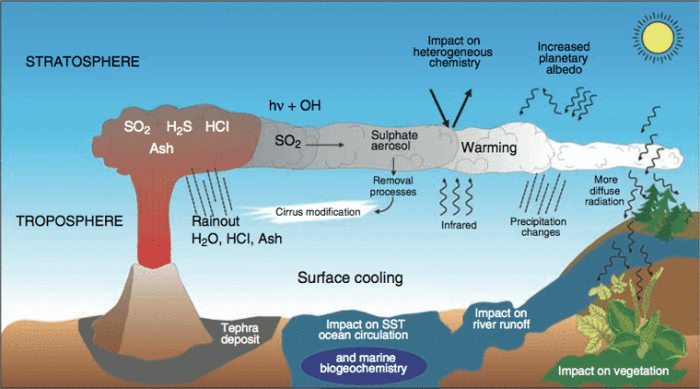
To complicate things, the climatic effects of volcanoes depend a lot not only on their SO2 stratospheric injection, but also on the latitude of the volcano and the time of the year. These factors have a significant effect on the dispersal of the cloud. Thus, some volcanoes have a global effect while others only a hemispheric one, or no effect at all, like the Mt. St. Helen's eruption of 1980, a strong volcanic eruption with no climatic effect.
When scientists want to concentrate on the warming produced by volcanoes, they look at CO2. Currently CO2 emissions from volcanoes are too small, about 1% of anthropogenic emissions. But, in the distant past the amount of CO2 produced by a much higher level of volcanic activity, particularly by large igneous provinces (LIP), might have been very considerable. Since mass extinctions, from the past in some cases, correlate well with LIP, there is a lively debate on whether SO2 and cooling, or CO2 and warming, caused the extinction, with the latter one being the most popular hypothesis today.
Volcanic activity and the Little Ice Age
The available evidence from El Chinchon and Pinatubo eruptions only supports a short-term effect from volcanoes on temperatures, lasting at most a few years. Based on this evidence volcanic eruptions affect weather, not climate, very much like strong El Niño events, but opposite. In fact an El Niño-like condition develops in the first year after large tropical eruptions, followed by a stronger La Niña-like condition in the second year (Sun et al., 2018). The La Niña condition recharges subsurface ocean temperatures, contributing to a rebound in temperatures once the volcanic stratospheric effect ends, around the fourth year.
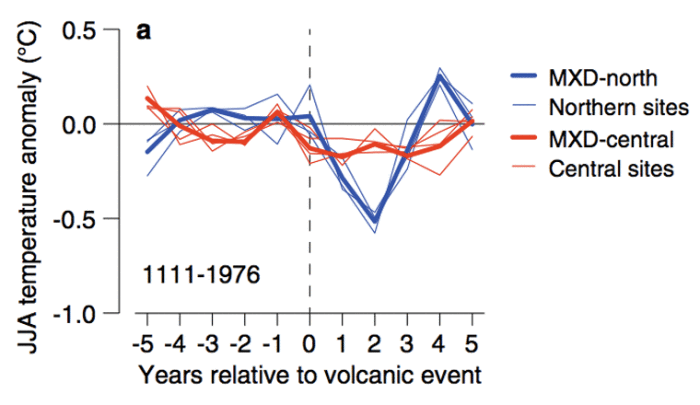
Defenders of a volcanic-LIA use models to support a much longer effect by larger eruptions that took place during the LIA, like the Tambora eruption of 1815, by clusters of eruptions, and by a proposed long-term oceanic effect from eruptions. While these explanations are possible, there is no evidence supporting them. Tree-ring analysis shows a similar weather effect for LIA volcanoes (figure 2). The solar-LIA hypothesis has the problem that the cooling started before some of the solar grand minima started and that the cold periods don't exactly match the low solar activity periods.
Most scientists, however, accept that the LIA was probably caused by a combination of solar and volcanic causes and the discussion is about which cause was more important. A clear possibility is that low solar activity prevented the recovery from volcanic cooling, prolonging its effects and acting synergistically to produce a bigger combined cooling.
However more information can be gained by studying the effect that climate change has on volcanic activity.
The effect of climate on volcanoes
The idea that volcanoes affected climate by causing cooling on a temporal scale of less than a decade was an old one, already reported in 1940, and in the early 1970's there was speculation that volcanoes could be a cause for glaciations. However, in the mid-1970's J. Roger Bray, the discoverer of the 2500-year solar-climate cycle (wrongly named Hallstatt), made the observation that moving to temporal scales of centuries to millions of years the correlation between "volcanic pulses" and glacial advances was the opposite. Some glacial advances appeared to precede by a few centuries the "volcanic pulses" that were supposed to be their cause, and over the past 2 million years major ice-sheet expansions had lagged behind "volcanic pulses" by up to 10,000 years (Bray, 1977).
By the late-1970's it was clear that the effect of volcanoes on climate was limited. As Rampino et al. reported in 1979:
Rampino et al. (1979) confirmed one of Bray's observation that major historical eruptions associated with cooling were taking place after decadal length temperature decreases had been initiated, so they asked if rapid climate change could cause volcanic eruptions, by means of stress changes on the earth's crust, through loading and unloading of ice and water masses and through axial and spin-rate changes."The eruption of Tambora in 1815, one of the largest eruptions during the past few thousand years, is associated with a hemispheric temperature decrease of only 0.5° to 1°C for 2 to 3 years. In this case, average global temperatures had already been decreasing since 1810 and then rose again in the 1820's."
This question was left unanswered and forgotten once scientific focus changed from cooling to warming in the 1980's. However, through better data collection the question reemerged at the turn of the century. Zielinski et al. published in 1996 the GISP2 ice-core record of 110,000 years of explosive volcanism (figure 3), showing that the transitions between colder periods (stadials) and warmer periods (interstadials) displayed increased volcanism. The following year McGuire et al. published a correlation between sea-level changes and the frequency of explosive volcanism in the Mediterranean. And in 1999 Glazner et al. published under the suggestive title "Fire or ice," that the anti-correlation between volcanism and glaciation extended for the past 800,000 years in the Californian volcanoes, located 300 km from the sea. This was also confirmed for continental volcanism in France and Germany by Nowell et al. in 2006.
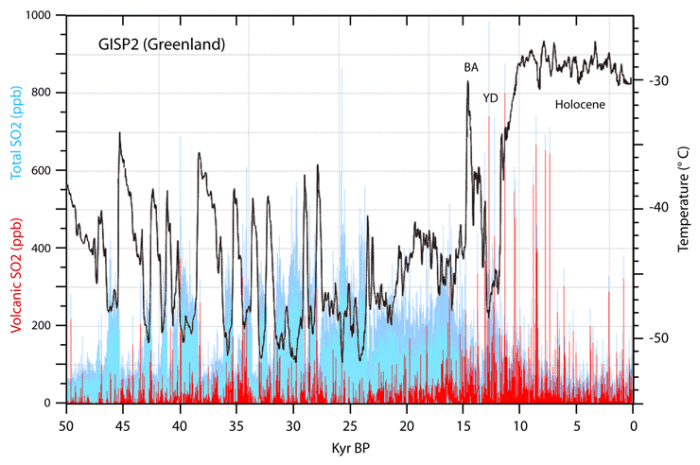
Then research turned to the mechanisms. Jellinek et al. showed in 2004 that Californian volcanoes were responding to ice changes in the obliquity (41-kyr) frequency with a time lag, related to glacial unloading, that was of a few kyr for silicic volcanism but of ~ 10-kyr for basaltic volcanism. They advanced the hypothesis that the decrease in pressure from ice melting stimulated dike formation leading to more explosive volcanism. But this is not the only hypothesis. Volcanism is terribly complicated, and caldera-forming volcanoes from the glaciated arc of Kamchatka seem to respond to glacial loading and show peak activity during glacial maxima (Geyer and Bindeman, 2011).
Kutterolf et al. conducted in 2013 the most comprehensive analysis to date of the temporal frequency of volcanism in the Ring of Fire, where most of the world's largest volcanic eruptions have occurred in the recent past. They built an extensive dataset of 408 tephra (volcanic ejecta) layer dates for the past million years from multiple coring sites down-stratospheric-wind from volcanic areas along the Pacific Ring of Fire. Frequency analysis of volcanic eruption activity shows a significant peak at the 41-kyr period with non-significant peaks also at the 23-, 82-, and 100-kyr Milankovitch frequencies (figure 4). The 41-kyr volcanic frequency peak coincides in period with the δ18O rate from benthic cores. Since changes in δ18O rate are anti-phased with obliquity, volcanism peaks roughly when the rate of change of δ18O is most negative, i.e. ~ 4 kyr after the greatest rate of sea-level rise and ice volume decline (figure 4).
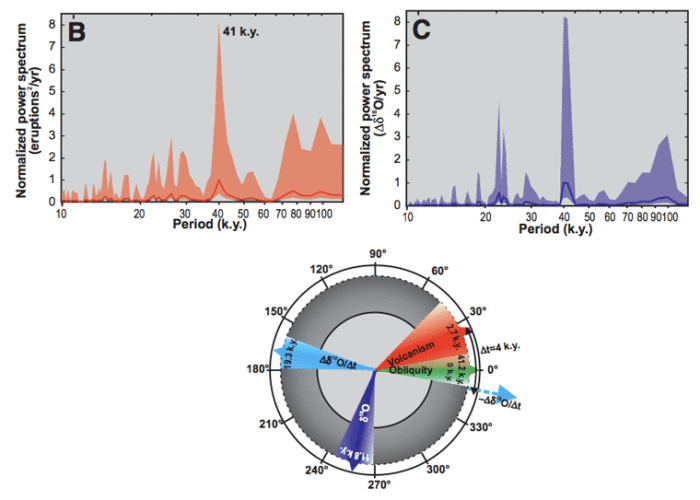
Ice cores (volcanic sulfate deposition) and volcanic (tephra layers) datasets independently show that the highest level of volcanic activity for the past 100,000 years took place between 13 and 7 kyr BP, with a rate 2-6 times above background level (figure 5c). Part of the lag with respect to the start of the deglaciation at ~ 18 kyr might be due to the melting starting at the Eastern Laurentide and Antarctic ice sheets that do not affect volcanic regions. After 7 kyr BP, once the ice sheets melted, volcanic activity has declined and has returned to background glacial-comparable levels.
Huybers and Langmuir (2009) have analyzed CO2 output by volcanoes at deglaciation, considering that the increase in subaerial volcanism due to melting must have been compensated in part by a decrease in non-ridge associated submarine volcanism due to the increasing load of sea-level rise. Their modeling indicates that half of the CO2 increase (~ 40 ppm) during deglaciation is due to the volcanic response to climate change, constituting an important feedback factor to glacial termination.
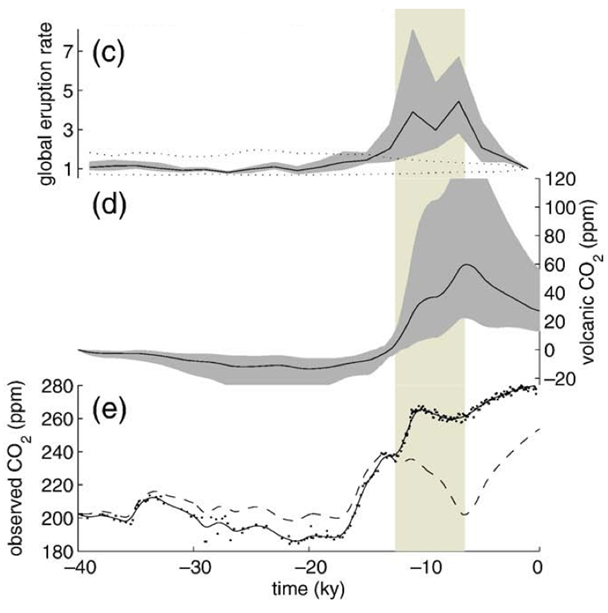
The Holocene Climatic Optimum, the warmest period of our interglacial, showed a level of volcanic activity 2-4 times higher than the Little Ice Age, the coldest period of our interglacial. Therefore, it is impossible that the LIA may have been caused mainly by volcanic activity.
Volcanic activity has no detectable climatic effect in the Pleistocene. Volcanic eruptions affect weather (a few years), not climate, and their only possible climatic effect is a hypothetical (but reasonable) feedback effect at glacial terminations through their significant contribution to CO2 increase.
However, climate change has a strong effect on volcanism. The effect of obliquity-linked ice unloading is very clear. Due to the asymmetric nature of ice changes, as melting is very rapid, but ice build-up is very slow, the effect of ice unloading has been well established, but that of ice loading has not. Anecdotal evidence since the 1970's suggests that ice loading might also increase volcanic activity, as eruptions have been observed after decades-long cooling periods, however, the evidence for this is not significant.
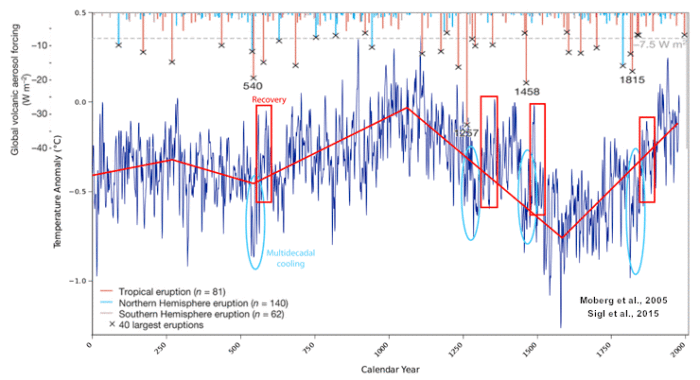
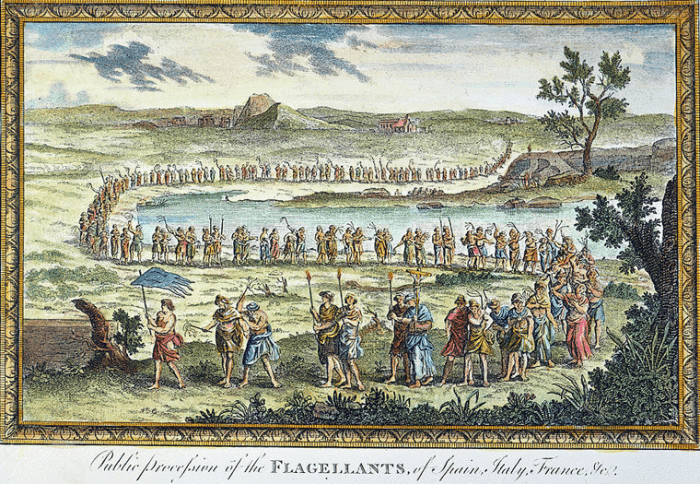
A final corollary is that the strong reduction in the continental cryosphere observed during the present global warming is likely to be paid down the road in the form of increased volcanic (and seismic) activity, due to ice unloading. Whatever its cause, the potential for a hazardous geospheric response to climate change is real (McGuire, 2010).
Bibliography
Bray, J. R. (1977). Pleistocene volcanism and glacial initiation. Science, 197 (4300), 251-254.
Esper, J., et al. (2013). European summer temperature response to annually dated volcanic eruptions over the past nine centuries. Bulletin of volcanology, 75 (7), 736.
Geyer, A., & Bindeman, I. (2011). Glacial influence on caldera-forming eruptions. Journal of Volcanology and Geothermal Research, 202 (1-2), 127-142.
Glazner, A. F., et al. (1999). Fire or ice: Anticorrelation of volcanism and glaciation in California over the past 800,000 years. Geophysical Research Letters, 26 (12), 1759-1762.
Huybers, P., & Langmuir, C. (2009). Feedback between deglaciation, volcanism, and atmospheric CO2. Earth and Planetary Science Letters, 286 (3-4), 479-491.
Jellinek, A. M., et al. (2004). Did melting glaciers cause volcanic eruptions in eastern California? Probing the mechanics of dike formation. Journal of Geophysical Research: Solid Earth, 109 (B9).
Kutterolf, S., et al. (2013). A detection of Milankovitch frequencies in global volcanic activity. Geology, 41 (2), 227-230.
McGuire, B. (2010). Potential for a hazardous geospheric response to projected future climate changes. Philosophical Transactions of the Royal Society of London A: Mathematical, Physical and Engineering Sciences, 368 (1919), 2317-2345.
McGuire, W. J., et al. (1997). Correlation between rate of sea-level change and frequency of explosive volcanism in the Mediterranean. Nature, 389 (6650), 473.
Moberg, A., et al. (2005). Highly variable Northern Hemisphere temperatures reconstructed from low-and high-resolution proxy data. Nature, 433 (7026), 613.
Nowell, D. A., et al. (2006). Episodic quaternary volcanism in France and Germany. Journal of Quaternary Science, 21 (6), 645-675.
Rampino, M. R., et al. (1979). Can rapid climatic change cause volcanic eruptions?. Science, 206 (4420), 826-829.
Stothers, R. B. (2000). Climatic and demographic consequences of the massive volcanic eruption of 1258. Climatic Change, 45 (2), 361-374.
Sigl, M., et al. (2015). Timing and climate forcing of volcanic eruptions for the past 2,500 years. Nature, 523 (7562), 543.
Sun, W., et al. (2018). A "La Niña-like" state occurring in the second year after large tropical volcanic eruptions during the past 1500 years. Climate Dynamics, 1-15.
Timmreck, C. (2012). Modeling the climatic effects of large explosive volcanic eruptions. Wiley Interdisciplinary Reviews: Climate Change, 3 (6), 545-564.
Zielinski, G. A., et al. (1996). A 110,000-yr record of explosive volcanism from the GISP2 (Greenland) ice core. Quaternary Research, 45 (2), 109-118.
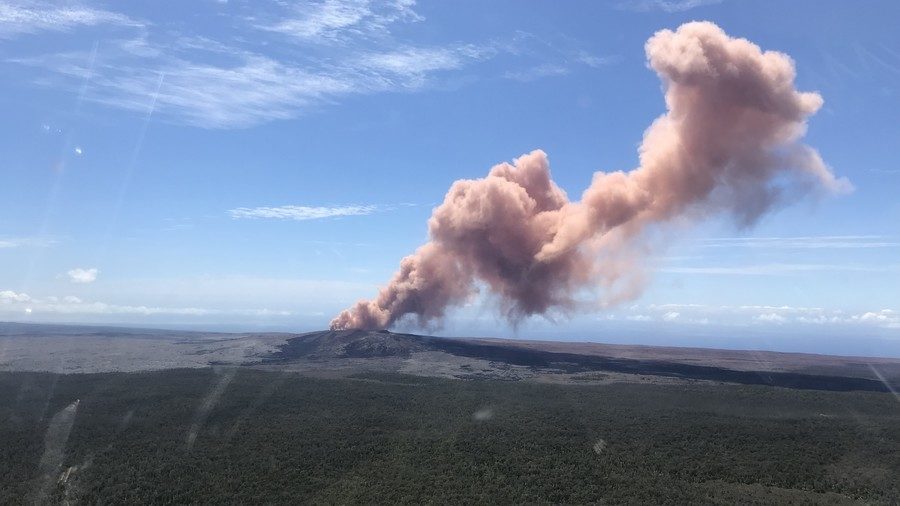



"Part of the lag with respect to the start of the deglaciation at ~ 18 kyr might be due to the melting starting at the Eastern Laurentide and Antarctic ice sheets that do not affect volcanic regions. After 7 kyr BP, once the ice sheets melted, volcanic activity has declined and has returned to background glacial-comparable levels."
It is hard to reconcile the existence of hypothesized ice sheets covering the northern hemisphere when evidence of human and temperate climate flora and fauna, including megafauna keep showing up in digs from Alaska to Nova Scotia, particularly in Edmonton and Calgary. This evidence is being dated to the ante-Clovis period. So how did they manage to feast and roam on top of such thick ice?
The ice core data strongly suggests the planet was warming up, until a cataclysm brought on a couple of "brief" cooling spells around 9500BCE. It is clear the "after-effects" of ice sheets, originally posed in the 19th century, was never caused by ice sheets at all.
The chief problem with climatology is the failure to account for extra-planetary systemic influences and the naive assumption of gradualism.